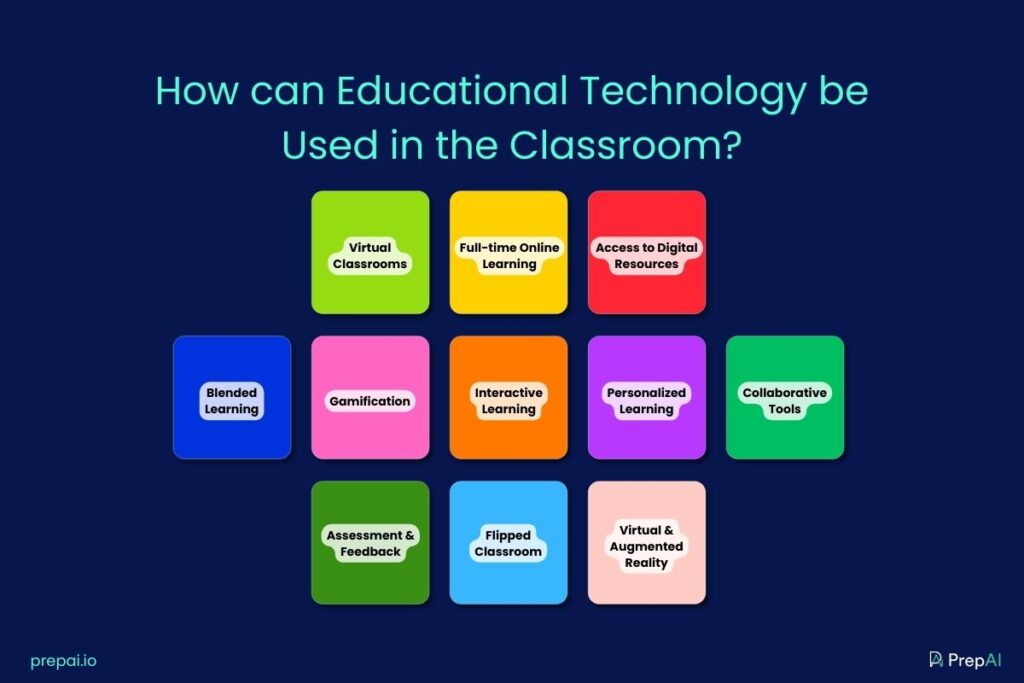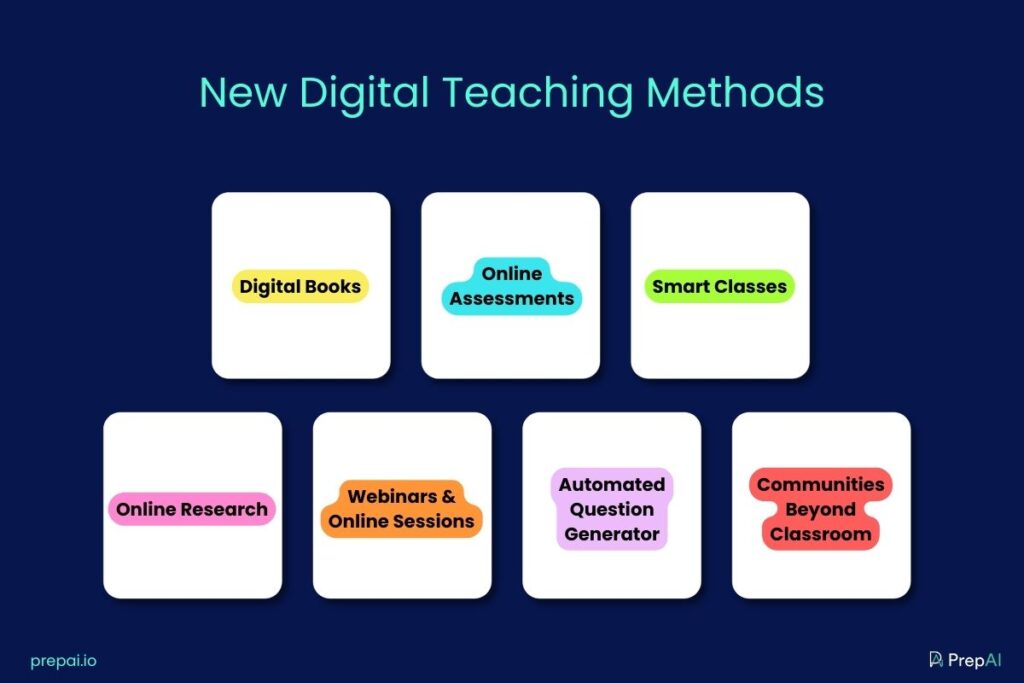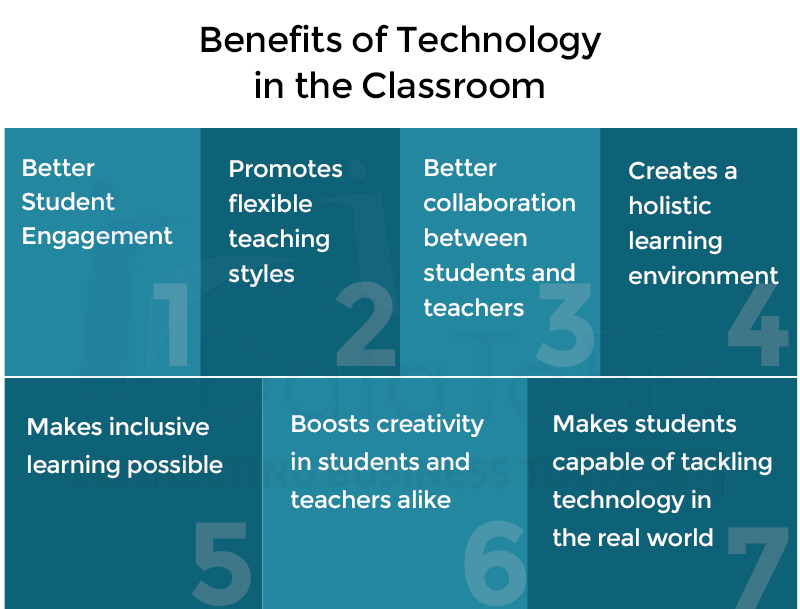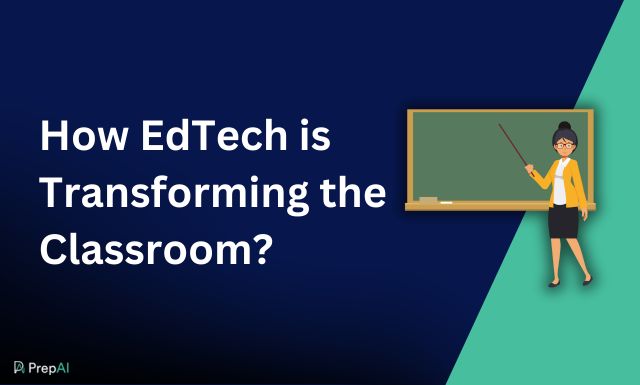Edtech is transforming the classrooms by including technology as a part of day-to-day learning activities. Edtech helps teachers, students, and management to redesign the teaching environment and enhance the learning experience. Discover how Edtech is bringing an innovative change to classrooms and educational institutions.
Technology has brought digital tools into the classroom to change the way we perceive education. Computers are no longer limited to the computer labs where students practice their computer skills. Computers and smart devices are now included in classrooms for everyday learning.
Today’s courses, certifications, and learning modules are different from traditional methods. Learning is now a 24*7 process where students have access to resources round the clock. The Covid-19 pandemic resulted in online classes, thus increasing the dependence on technology.
In classrooms, technology has a much bigger role to play. Be it digitization of textbooks, 3D imaging, smartboards, or question generation using NLP, technology is making a classroom a lively and interactive place. Students actively participate in learning and are no longer limited to being passive listeners. Teachers make the classes more fun and engaging using projectors, audio equipment, and other advanced tools.
Edtech is also helping educational institutions streamline their classrooms to make them more inclusive and student-friendly. Inclusive learning is fast gaining prominence and is being adopted by various schools and establishments. Technology makes inclusive learning possible by bridging the gap between educators and students. Educational institutions with inclusive classrooms will find easy acceptance in society, given the increase in awareness about diversity and inclusivity on a global level.
How is Digital Learning Changing School Education?
Digital learning is where you use technology in teaching to make lessons, syllabi, and courses more accessible to students. It removes the constraints traditional learning methods have placed on students and teachers. It’s not just about using a computer or a smartphone. The intent is to give more autonomy to students to decide and choose a learning methodology that aligns with their strengths and weaknesses. For example, a student who needs a visual presentation to understand a concept can rely on PPTs, 3D images, holograms, etc. Students with visual disabilities can listen to the courses and read the study material using text-to-speech technology.
Such freedom of using technology in classrooms encourages students to feel motivated and ready to tackle subjects/ topics they find hard to understand. Also, students who don’t feel comfortable with face-to-face interactions can communicate with the teacher through electronic means like emails, messages, etc. Then, they can be helped to overcome their fears.
The perspective is gradually changing from considering smartphones a distraction in the classrooms. While there’s no denying the negative effects of smartphone dependence, teachers are developing innovative ideas to reduce the side effects and bring a positive shift. For example, instead of banning smartphones, teachers can let students use their devices to participate in online quizzes, review peer-submitted assignments and give feedback, search for topic-related information for discussions, etc.
Digital learning has been bridging the gap between marginal communities and education in third-world countries. Students from rural areas may not have high-end classrooms, but many of them have smartphones that can give them access to study material and lessons. Teachers have been taking classes online for students who cannot visit the school every day but want to study.
How can Educational Technology be Used in the Classroom?

1. Virtual Classrooms
Virtual classrooms are available for both part-time and full-time learning. Educational institutions now offer dual enrollment options, summer programs, and advanced courses for students who wish to study online or supplement their classroom education with virtual learning. By providing virtual classrooms, students have more options to choose from and can find the most suitable way to learn.
2. Full-time Online Learning
Educational institutions can provide full-time online classes for students, eliminating the need for physical classrooms. Platforms like Udemy, Coursera, Teachable, and LearnWorlds operate solely on virtual classrooms and online learning (full-time and part-time). Various state and district-operated schools in the US, such as The Florida Virtual School and Karval Online Education, also offer full-time online learning to students. It also erases geographical boundaries and allows students from one country to attend classes in another.
3. Access to Digital Resources
Digital resources are open educational resources that anyone can access. Educational institutions provide free online resources, such as ebooks, podcasts, webinars, and research papers, for students to use for project work and further learning. Schools like Leadership Public Schools and Vail Unified School District compile valuable materials to create an open-source curriculum that can be used by educators and students across different states and institutions. Moreover, EdTech apps often build virtual communities for teachers and students to access assignments, games, question papers, etc., created by others.
4. Blended Learning
Blended learning combines online learning and face-to-face teaching, accommodating students with diverse needs and abilities. Edtech helps students and teachers optimize their time and efforts. This approach also saves resources and reduces costs for educational institutions without compromising quality. Typically, a true blended learning environment is a classroom with helpful technology. For example, the teacher might use 3D images or holograms to explain complex concepts in the classroom.
5. Gamification
Gamification is becoming widely popular in both enterprises and classrooms. It includes game-like simulations, learning activities, winner boards, and badges to make learning more competitive and entertaining. Edtech startups work with educational institutions to integrate gamification as part of the classroom experience, motivating students to excel. AI-powered quiz generator tools also offer gamification by awarding scores, ranks, and badges to students based on their performance in the tests. They can download certifications after successfully completing the quiz.
6. Interactive Learning
Generally speaking, interactive learning is where students are actively involved in the process instead of being passive listeners. In the traditional teaching methods, students were expected to sit still and be silent. While discipline is still necessary, students are now expected to participate by asking questions, sharing their opinions, joining group discussions, etc. Tools like smartboards and interactive projectors make lessons more engaging. Students can participate in interactive activities, quizzes, and games that reinforce learning, making the classroom experience more dynamic.
7. Personalized Learning
Educational software and apps can tailor lessons to individual student needs, allowing them to learn at their own pace. Rather than expecting every student to study in the same manner, the lessons, pacing, and medium of learning can be adjusted to suit the student’s capabilities. Platforms such as Khan Academy and Duolingo adapt to each student’s progress, making learning more personalized.
8. Collaborative Tools
Applications such as Google Classroom and Microsoft Teams facilitate collaboration among students. These tools enable students to work on group projects, share resources, and communicate easily, improving teamwork and collaboration. In times when teachers are worried about diminishing interpersonal skills in children and young adults (especially after the COVID-19 pandemic), collaborative educational tools provide an excellent opportunity for students to work with each other and interact at least virtually.
9. Assessment and Feedback
Technology can streamline the assessment process. AI Tools like Kahoot!, PrepAI and Quizizz provide instant feedback, helping students understand their strengths and areas for improvement, enhancing learning through timely assessments. Assessment tools are helpful EdTech applications for teachers to track students’ performances and understand their abilities. The tools provide analytics, which can be used to personalize feedback.
10. Flipped Classroom
In a flipped classroom approach, students learn new content at home (or before the classroom session begins) through videos and online resources and then apply that knowledge in class through activities and discussions, shifting the focus to application-based learning during classroom hours. As the name suggests, it is a flipped or reversed version of traditional learning. It works on the idea that the time students spend in classrooms should be productive and encourage them to participate in higher-order thinking activities.
11. Virtual and Augmented Reality
Virtual and augmented reality technologies can create immersive learning experiences. For example, students can take virtual field trips to historical sites or explore scientific concepts in 3D environments, providing a deeper understanding of complex topics. AR and VR allow students to gain an immersive experience with the outside world without stepping out of the classrooms. The technology is used in the medical field to train junior doctors in performing surgeries.
More on How to Use Technology in the Classroom
The importance of technology in education can no longer be denied or ignored. Resisting the changes will likely cause more harm and increase the negative effects. Creating awareness in students about the best ways to use technology in the classroom will go a long way in making them healthy and assertive adults. Apart from the methods mentioned above, there are other ways to use digital learning technology in education.
Digital Libraries
The Internet has many online libraries (open-source, closed-source, free, and subscription models) for students of various age groups and specializations to collect more information, make notes, cross-check or fact-check data, etc.
Encouraging Self-Discipline
Teachers worried about smartphone addiction in students can take proactive steps to create awareness about the negative effects of depending on devices and make students develop their own methods to discipline their actions. For example, instead of putting a blanket ban on using generative AI tools, teachers can turn it into a discussion and comparative study to help students use technology correctly (using ChatGPT for research instead of plagiarizing assignments).
Time Management
Another concern for teachers is that students spend too much time scrolling through social media platforms instead of focusing on their assignments or class work. However, the same devices can be used to set time limits and other controls. Time management apps are helpful for students to plan and prioritize their work.
Manage Active Students
Some students are termed hyperactive or restless (and even disruptive) since they complete their work quickly and get bored. This leads to mischief and other trouble. Teachers can tackle such issues by giving them extra work, preferably to do something on their smartphone or tablet so that they don’t disturb others but also spend time learning something new.
How Digital Education is Transforming Teaching Methods

Digital Books
Textbooks are not limited to physical copies students need to carry to the classrooms every day. Syllabus books are converted to digital copies and shared as Kindle books, PDFs, etc. so that students can easily view them on their smart devices. Once the PDF is downloaded on a device, there’s no need for an internet connection either. This gives students more time and freedom to study whenever they want. On a side note, contributing to environmental safety, there are fewer to no papers involved in the process.
Smart Classes
Classrooms are not limited to blackboards and chalks. Projectors don’t have to be used only once in a while. The smart classroom infrastructure makes it easy for teachers to transform the setting from traditional to digital with minor adjustments. This empowers educators to choose and mix different teaching styles as per the subject, topic, and students’ learning abilities.
Online Research
Almost everything is available at our fingertips, thanks to the internet. By creating a dynamic classroom, educators can encourage students to be prepared for the class and become active participants. Teachers and students can discuss a topic in detail by researching online material from various sources.
Webinars and Online Sessions
Teaching is no longer considered one-way communication. Webinars and online classes allow two-way communication by giving students a chance to ask questions, comment on their opinions, fill the questionnaires, and so on. Distance learning doesn’t limit the interaction between people when technology is used.
Automated Question Generator
Surprise tests don’t have to take too much time and energy. Platforms like PrepAI generate questions from text using NLP algorithms. The AI-based automated platform helps teachers conduct random assessments to test their students’ knowledge.
Online Assessments
The assessment tests can be conducted online or offline. Online assessments are easier for educators, students, and establishments. The assessments can be a combination of quizzes, subjective, descriptive, simulations, real-time problem solving, and so on.
- Educators can use software to prepare and conduct test papers.
- Students can take the test anywhere.
- Educational institutions don’t have to spend excess on infrastructure and resources for the assessments.
Communities Beyond Classroom
Educational institutions can create a strong community that goes beyond the classrooms. The teacher’s role doesn’t end with classroom sessions. The faculty and students interact with each other using various platforms and apps. Communication and collaboration become more effective when technology is involved in teaching.
What Types of Technology can be used in the Classroom?
Over the years, we’ve seen technology increasingly becoming a part of classrooms. While some establishments have been quick to adopt, others took their time to weigh the pros and cons. Some educational institutions are yet to begin the process and find that they have to invest more to replace the outdated systems. Early adopters with a proper IT strategy are faring better in 2021 and are more prepared to include technology in their institutions.
Projectors
Projectors have been around for decades, even though their use has been limited in most establishments. Now, projectors take the prime spot where teachers use them every day in the classrooms. The latest interactive projectors (BenQ’s Interactive WXGA) can display images on any flat surface and offers an array of features for customization.
Smartboards
A smartboard is an advanced version of the black/ whiteboard at school. Teachers can write using real or digital markers to convert the text/ content into a tangible element. Even more advanced smartboards like the ones designed by Promethean offer touch screens on smartboards to customize the content displayed on the screen.
Smart Devices and Laptops
Students can bring their smart devices, laptops, and recording gadgets to the classrooms to make notes. Students with disabilities can use recording and translation software to understand the lessons. Educational institutions are working on making their classrooms more conducive for all kinds of students.
Cameras and Audio Equipment
Cameras and audio equipment have been a part of US classrooms for a long time. The institutions are taking things one step ahead by allowing students to record their activities and assess them later. The use of microphones and speakers makes the teacher’s voice audible in every inch of the classroom. It’s easier to concentrate and record the lessons in a classroom with good acoustics.
Other Tools and Solutions
The following are some of the other tools and applications used by educational institutions to create a holistic learning environment in the classroom.
- Adobe Spark Video: This software help students learn through self-teaching. Students can use the templates and features provided to create attractive video lessons to learn throughout the year.
- Google Classroom: Google Classroom helps teachers organize lessons and activities from a single platform. All aspects of learning can be streamlined using this free product by Google.
- Classcraft: Classcraft is free and paid software that uses gamification to provide a harmonious learning environment in the classrooms. It helps students improve their academic and social skills.
- YouTube: YouTube has an endless collection of lectures, webinars, tips, training sessions, etc. Educational institutions are taking things further by asking teachers to link their Google accounts and upload lessons for students to watch and learn.
- Nearpod VR: Virtual Reality in classrooms is now a reality in many institutions. Nearpod VR has 450+ virtual tours for students to explore reality through virtual means, that too, without stepping out of the classroom.
Does Technology in the Classroom Improve Learning?

Using technology in the classroom can definitely improve learning if used properly.
- Using the latest AI-based tools results in better student engagement.
- Inclusive learning is possible with advanced technology.
- Technology helps educators use flexible teaching styles to suit their students’ learning abilities.
- Technology allows for better collaboration between students,and teachers. It bridges the gap between teacher and student and provides them a way to communicate and interact.
- Technology helps create a holistic learning environment in classrooms.
What are the Positive and Negative Effects of Using Technology in Education?
As with every other field, there will be pros and cons when using technology in classrooms. Teachers and educational institutions should create an environment where the negatives are minimized so that students can benefit from the positive aspects of using technology for learning.
What are the positive impacts of using technology in education?
- Technology is eliminating the barriers between students and educators. Be it lack of resources, geographical distances, cultural, lingual, etc., technology is making education accessible for all.
- Using technology in education boosts creativity in students and teachers alike. Students can experiment and explore while teachers can try unconventional teaching styles to suit students’ requirements.
- Digitally trained students are more aware and capable of tackling technology in the real world and navigating the internet in relative safety.
- Teachers and students have access to more resources, thanks to the digitization of textbooks and study material. Moreover, students don’t need to wait to access the limited number of library copies.
- Personalization is the biggest advantage of including technology in classrooms. Educational institutions can create inclusive learning classrooms where all students can study together without any difficulty or discomfort.
- Technology in classrooms works as bait to attract students who otherwise don’t find education interesting. When classrooms are creative instead of boring/ dull, more students will be excited to attend classes every day. This will, in turn, help them gain more knowledge and build better self-esteem.
What are the negative impacts of using technology in education?
- Relying more on technology and eLearning limits real-life social interactions. Students will grow up wanting to be isolated and away from people or get uncomfortable among crowds. Educational institutions can prevent this by creating interactive classes in the school/ college building. Interpersonal skills are different in face-to-face interaction and online. Excessive use of social media is causing psychological and emotional problems in children and adults. Establishments and educators should ensure that kids learn how to interact with others outside the internet.
- With assignments being submitted online, students learn to type better. This affects their handwriting as they lose touch with writing. Many young kids today can’t write cursive as the previous generations could. This can be avoided by asking students to write their assignments and scan the papers (or take a picture) for online submissions.
- Excess screen time has been a major cause of concern for a while. It’s up to the educational institutions, teachers, and parents to have a comprehensive schedule that limits screen time for students.
- Educational institutions that haven’t yet adopted technology will have to make heavy investments to develop the infrastructure and convert the classrooms. However, using platforms like PrepAI will help optimize the investments, thanks to the cost-effective pricing.
- Sadly, many teachers are not fully equipped to use technology in classrooms. Though the pandemic has pushed teachers to learn and adapt, we still have a significant number of teachers struggling to use advanced technology. Educational institutions can solve this problem by conducting training sessions for teachers to feel comfortable with technology in classrooms.
- The biggest negative impact of technology on education is the abundance of misinformation on the internet. From news to research papers, there are different versions for the same incident/ topic. Students are at risk of using misinformation for their projects or learning the wrong version of events. Tackling this issue is tough because fact-checking websites are just as biased in many countries.
Conclusion
The success of any educational institution depends on how well it adopts the latest technology and overcomes the challenges of setting up a holistic classroom.
Technology can positively transform the classrooms with proper planning and implementation. Edtech startups and solution providers play a vital role in assisting education establishments to revamp their infrastructure.



